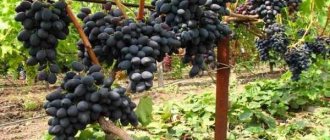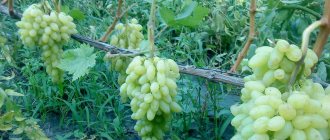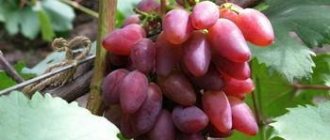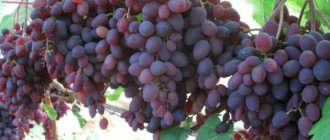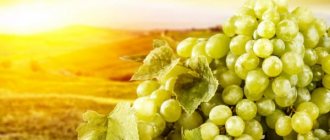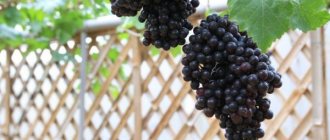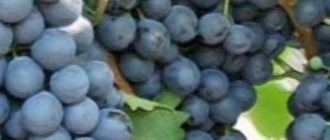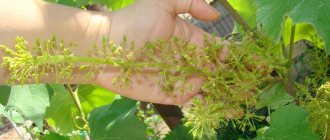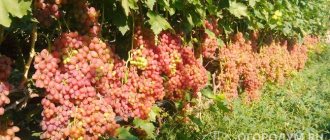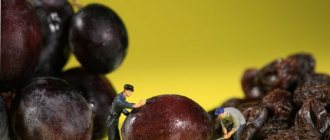Origin and cultivation history
The word "kishmish" comes from Persia. The literal translation is “dried grapes.” Central Asia is considered to be the birthplace of the variety, and the first mention of Kishmish is found in an ancient Uzbek fairy tale of the 13th century.
Kishmish, unlike other types of grapes, has very small seeds or none at all. Such grapes owe their appearance to natural mutation. The winegrowers, noticing the results of natural “selection,” continued their experiments. As a result, many varieties and varieties of Kishmish were obtained - white, pink, dark.
Origin
When eating grapes, the only annoyance is the seeds. To get rid of this minor trouble, many centuries ago a variety was bred in Central Asia, which was called “kishmish” - “squashed grapes”, indicating its purpose - to produce tasty raisins.
Today, dozens of varieties of seedless grapes are grown, but the closest to that same variety is White Kishmish.
Seedless grapes of white color with small berries and a distinct sweet taste have been known to man since ancient times.
Probably, people thought about how to get rid of seeds and purposefully began to select plants with the smallest seed size, crossing them.
As a result, the seeds in sultanas are so small and soft that they are almost not felt when chewing. True, at the same time the grapes lost the ability to reproduce naturally. Since then it has spread vegetatively.
As a result of selection of Kishmish White and crossing with other varieties, many varieties of seedless grapes appeared, including berries of different size and color.
White raisin is one of the most popular cultivars in the world: it is grown on all continents where it is warm and sunny enough: in Australia, the USA, South Africa, not to mention Asian countries.
Botanical description
Kishmish unites a group of varieties with similar botanical features and characteristics:
- Bunches. Dense or slightly loose. The berries are medium. The color of the fruit depends on the variety.
- Berries. With a dense structure, lightweight. Does not contain seeds. There are hybrid varieties in which the seeds are very small and undeveloped, and are practically not felt.
- Pulp. Very sweet, contains a lot of sugars - 18-25%.
Kishmish is a grape ideal for the production of raisins. Sweet, seedless berries are what you need for this popular and valuable product.
Wintering pink raisins
The grapes, formed into a vertical vine on an arbor or support, are pulled together into a single bunch and covered with either burlap or other suitable breathable material and secured with a wrap. The use of this method of protecting a plant from the cold helps preserve its shoots from the formation of an ice crust. At the same time, the pink sultana receives the necessary ventilation and warmth from the sun.
Kishmish varieties and their characteristics
Thanks to selection, many southern crops, previously unavailable to most regions of the Russian Federation, today grow safely in temperate climates, in Siberia and the Urals. Let's look at the most popular varieties of sultanas that can withstand Russian frosts.
Radiant
This is the only variety of sultanas included in the State Register today. “Radiant” is recommended for the Lower Volga and North Caucasus regions. The variety is mid-season, ripens in 125-130 days. The brushes are cone-shaped, of medium size, weigh about 400 g. Individual specimens reach a weight of 1 kg and a length of 40 cm. The berries are elongated-ovoid in shape, with dense pink skin. The weight of the berries is 2.5-4 g. There is a taste of nutmeg.
Pros:
- very tasty berries, tasting score – 9 out of 10;
- high yield - more than 120 centners per hectare;
- resistance to gray rot, mildew and oidium;
- The berries tolerate transportation well.
Minuses:
- low frost resistance;
- high yield turns into a disadvantage - grape branches often break under the weight of the grapes;
- Due to high yields, berries may also become smaller and their sugar content reduced.
Moldavian
Kishmish of medium ripening period. From the moment the buds open to the ripening of the berries, 155 days pass. The bushes are vigorous, with large tassels. The weight of the bunches is 600 g. The fruits are round or oval, light purple with a waxy coating. The weight of the berries is 4-6 g.
Pros:
- pleasant, harmonious taste;
- winter storage – 180 days;
- transports well.
Minuses:
- low resistance to mildew, gray mold and leaf roller;
- frost resistance is satisfactory - the variety can withstand frosts down to minus 18°C.
Watch a review of the “Moldavian” variety of sultanas in the video below:
White
It takes 160-175 days for the fruit to fully ripen. This mid-late variety can be grown in the middle zone. The clusters are medium-sized, cylindrical. Weight – up to 250 g. The fruits are small. Color – lemon or amber yellow. The skin is transparent and thin. The berries are sweet and sour.
Pros:
- average frost resistance;
- delicious berries;
- no seeds.
Minuses:
- low yields;
- low resistance to diseases and pests;
- poorly transported.
Due to the poor transportability of White sultanas, it is more often used for drying than for making wines and juices.
Rusbol
The grapes ripen in 115-125 days. It has large, conical clusters, weighing up to 1 kg. The berries are oval-shaped, white. Very large. Weight – 8-10 g. Taste is pleasant. Rudimentary seeds are found in the pulp.
Pros:
- high frost resistance – up to minus 25°C;
- consistently high productivity;
- resistance to fungal infections;
- obtaining high-quality raisins;
- attractive presentation;
- tolerates transportation well;
- Suitable for table use and for drying.
Minuses:
- branches under the load of harvest can be overloaded and break - normalization is needed;
- there are seeds in the berries;
- In rainy weather, cracking of the berries occurs.
There is an improved version of Rusball - improved Rusball, also known as 13-3-6-2 Elf. It is distinguished by earlier ripening.
Century
Century Grapes represents the American group of sultanas. It was introduced in 1966, but is still very popular. It ripens in 120-125 days, so it belongs to the mid-season varieties. The plant is vigorous, with conical, medium-dense clusters. The weight of the bunches is 700-1200 g. The color of the berries is yellow-green. Weight – 6-9 g.
Pros:
- large bunches;
- sweet, homogeneous, slightly crunchy pulp;
- balanced taste with nutmeg aroma;
- resistance to cracking of berries;
- a large number of bunches on the vine;
- the berries are suitable for the production of raisins;
- good frost resistance - down to minus 25°C.
The downside is that the shelf life is not good enough. During storage, the berries quickly acquire a brown tint and lose their visual appeal.
The “Centenary” variety is better known to gardeners as “Senteniel Seedlis”, which means “seedless century”.
Jupiter
This is one of the youngest varieties of sultanas. It was released in the USA. The berries ripen in 105-125 days. The bushes are medium-sized, frost-resistant, self-pollinating. The clusters are cylindrical, with a “wing”, converging into a cone. The berries are large, oval, dark blue, with a nutmeg aroma. The weight of the bunches is 200-500 g, the weight of berries is 4-7 g. The variety is used for drying and fresh eating.
Pros:
- the thick skin prevents wasps from damaging the berries;
- stable yield;
- withstands 30 degree frosts;
- good transportability.
Minuses:
- the berries fall off if the bunches are not picked in time;
- sometimes rudiments of seeds are found.
About sultanas “Jupiter” watch the video below:
Zaporozhye
The variety was named after the city where it was bred. The clusters are cone-shaped, large, reaching a weight of up to 1.5 kg. The weight of the berries is 2-2.5 g. The shape is oval, the color is dark purple. Ripens very quickly - in 110-120 days.
Pros:
- consistently abundant fruiting;
- unpretentious to care;
- beautiful and tasty fruits;
- self-pollinates, is a good pollinator for other varieties;
- not afraid of mildew, rot and oidium;
- withstands frosts down to minus 26°C.
Minuses:
- small berries;
- due to overload, branches may break off - large stepsons need to be pruned;
- the berries are somewhat watery;
- fruits gain sugar content late;
- enhanced education for stepchildren;
- berries are poorly stored;
- the fruits are attacked by wasps - for some reason these insects love Zaporozhye raisins more than other varieties.
Hungarian 342
This is one of the most popular dessert varieties of sultanas. It belongs to the early ripening category; fruit ripening takes from 110 to 115 days. Plants are vigorous with large clusters. The weight of the brushes is 300-500 g. The pulp is of a delicate consistency, the taste of nutmeg is felt. The color of the berries is light green, with a golden sheen. Weight – 2-3.5 g. Fruit shape – ovoid.
Pros:
- frost resistance – down to minus 26°C;
- fruits are ideal for drying;
- increased resistance to fungal diseases;
- The skin is thin, the fruits are easily digestible, including by children.
Minuses:
- clusters that are not picked on time lose their commercial properties;
- berries may have a rudimentary feature - seeds;
- small clusters.
Veles
Early ripening variety. The ripening period is 95-105 days. A self-pollinating variety, but in the presence of pollinating varieties, the yield increases by 20%. The clusters are very large - weighing up to 3 kg. The shape of the bunches is cylindrical or conical. The fruits are large, oval, light pink, with an amber tint. The berries appear transparent. Weight – 5 g. Aroma – nutmeg notes.
Pros:
- very thin skin;
- no seeds;
- high productivity;
- ripened bunches, remaining on the vine, do not lose their taste properties for up to 45 days;
- pleasant taste, with a hint of nutmeg;
- The berries, when ripe, do not fall off.
Minuses:
- frost resistance is average - up to 21°C, the variety needs shelter;
- the grapes are attacked by bees;
- In rain and dampness, the berries deteriorate in presentation.
Berry
The fruits are 0.15-0.18 cm in size. They are soft and fleshy.
- Early varieties ripen in 11-115 days.
- The berry weighs 2-3.5 g.
- The shape is elongated, reminiscent of an egg.
- The color varies from light green to golden.
- There are no seeds.
- The density is moderate, it depends on the year and ripening conditions.
Taste and features
The berries contain 21% sugar. Acidity 6-8. There is a hint of nutmeg, leaving a pleasant aftertaste.
- Attracts grapes with fleshy berries with thin skin
- Suitable for harvesting raisins. This can be done by leaving the crop on the bush using a household electric dryer.
Marketability of berries
Kishmish cannot be called a profitable product. The bunches are not always dense - this impairs sales. With good yield, the clusters are formed large, there are no problems with sales. Winegrowers often do not plant many grape bushes for fear of losing possible profits. The advantage is the ability to stay on the bush for a long time while maintaining its appearance.
Where does it grow?
Kishmish has long left Central Asia - today this grape is grown in a wide variety of climates. There are varieties - early ripening and frost-resistant, which grow safely in regions with harsh winters and short summers. But most of all, these grapes love sandy soils, rich in potassium and phosphorus, and light winds.
Ideal conditions for growing sultanas are in Crimea. The northern border of distribution stretches along the Kyiv-Saratov-Barnaul line. But it does not stop experienced gardeners - they manage to grow frost-resistant varieties of sultanas much further north. Of course, sultanas in regions with frosty winters must be covered for the winter.
The main condition for sultanas to bear fruit is at least 180 frost-free days a year.
Black finger
A cultivar characterized by high frost resistance.
- The berries usually ripen 150-160 days after the end of flowering of the vine.
- A vine without shelter can withstand frosts of up to 22 °C; in regions with cold winters, the vine requires shelter.
- The clusters are very large, heavy, their weight often exceeds 2 kg.
- The shape of the bunch is asymmetrical cylinder.
The shape of the berries is elongated, their length reaches 3 cm, they are quite thick and their weight is sometimes quite large - up to 14 g. The berries are characterized by their table purpose. The color of the berries is almost black. The taste of the berries is no different; experts consider it simple, but there are nutmeg notes.
Photo: Kishmish Black Finger
Advantages and disadvantages of sultanas in general
Kishmish is a popular group of varieties that winegrowers and ordinary amateur gardeners value for:
- no seeds - the berries are convenient for eating fresh and for processing;
- versatility - the fruits are used for making raisins, wines, juices;
- sweetness and excellent taste;
- relatively high frost resistance - up to minus 25°C;
- good pollination abilities - all varieties of sultanas make excellent pollinators;
- nutritional value and medicinal properties of berries - they support the heart muscle, normalize blood pressure;
- high yield - 200-250 centners per 1 ha;
- precociousness;
- good rooting of cuttings and high-quality ripening of fruits even in northern regions;
- preservation of presentation and taste during long-term transportation;
- fruit resistance to cracking due to changes in temperature and humidity;
- the external attractiveness of the plant - sultanas can be used for decorative purposes.
Flaws:
- In some varieties, the fruits, when overripe, are prone to shedding - you have to vigilantly monitor their ripening in order to harvest on time.
- Satisfactory resistance to gray rot, oidium and mildew - the bushes require regular treatment.
Main types of Kishmish
There are a large number of varieties of the Kishmish grape variety. Below are some of the most popular ones.
- Red raisins are vigorous. The weight of each bunch ranges from 400 to 600 g. They have a conical shape. Pea growth is not typical for this species. Medium-density red berries are large in size, they weigh 4-5 g and have a nutmeg taste.
- Kishmish Radiant is considered a very high quality variety. The ripening period is characterized as early-medium. The bushes are medium or vigorous. The leaves are medium in size and grow in a heart shape. Of all the Kishmish varieties, only this one was included in the state register. The ripening of these high-calorie grapes occurs in 125-130 days.
- The Black Finger variety was developed by the Israeli company Volcany Center. Known for its high yield and exquisite taste.
- Kishmish Nakhodka has pink sweet berries of medium size. The mass of the bunch is 0.7-1.4 kg. Ripening time is 115-125 days.
Landing Features
If you want to grow sweet sultanas on your site, choose a variety that suits your region. Then select and prepare the site, prepare everything you need for planting.
Deadlines
Kishmish can be planted in both autumn and spring. In the homeland of the variety, and in the southern regions of Russia, grapes are usually planted in the fall - in October or November. A month and a half before frost, the root system of the grapes has time to get used to the new conditions, and the seedling has time to get stronger and take root.
In regions with frosty winters, it is preferable to plant Kishmish in the spring - so that the seedlings are not damaged during sudden frosts. Spring planting is carried out before the onset of sap flow, when the plant is still dormant.
The optimal soil temperature is +10°C. Grapes should not be planted in colder soil - the roots may freeze. Typically, such conditions are created in April-May.
Seedlings are planted in the fall; the best time for planting cuttings is spring.
Site selection
Recommendations for choosing a site for planting Kishmish:
- Good sunlight is necessary - these grapes will not grow in dense shade.
- There should be no trees nearby - competition for water and nutrients will begin.
- Drafts and gusty winds are excluded; grapes need peace and comfort.
- The best option is a sunny area, facing south or southwest, flat or with a slight slope.
- A good solution is to land at a structure blocking the north. Usually, grapes are planted near the stone walls of sheds, garages, etc. But this should not be done near the walls of a residential building - due to excessive watering, the foundation may settle.
- Kishmish can grow on any soil, but it bears fruit best on loose and nutritious soils - they quickly warm up and promote the penetration of moisture and oxygen to the roots. Similar properties are characteristic of loamy and light loamy soils, as well as chernozems on calcareous and chalk rock. A suitable option is sandstones, but it should be borne in mind that they quickly lose water and nutrients.
- Kishmish cannot be planted on soils located closer than 1 m to rocks, or in swampy and saline areas.
The sweetness of Kishmish depends on the amount of sun. Light shading is allowed only in the first years of growth. These grapes are distinguished by vigorous bushes, so they can be easily brought into the zone of maximum illumination.
Soil preparation
The soil is prepared in advance. If the grapes are to be planted in the spring, then the site is prepared in the fall. Proceed in the following order:
- Clear the area of everything unnecessary - remove stones, weeds and their roots, level the surface.
- Dig the area 65-70 cm deep. When digging, add humus - 3-4 kg per 1 square meter. m, and superphosphate - 100 g per 1 sq. m.
- When digging, do not try to break up large lumps - during the winter they will accumulate a lot of moisture and in the spring they will fall apart.
- If necessary, adjust the composition of the soil - if it is acidic, add 1-1.5 kg of phosphate rock. If the soil is heavy or clayey, add coarse sand, humus and crushed stones. Loose sandy soils require peat, manure or black soil.
Selection of seedlings
All subsequent development of grapes and its productivity depend on the health of the planting material. How to choose seedlings for planting:
- Young planting material, 1-2 years old, tolerates transplantation best.
- The root system must be powerful, strong, without defects or traces of disease. Let the seller cut off a piece of the root so that you can look at the cut - if it is light, then the roots are alive.
- The stem should be smooth, without signs of infection. If there are spots, swellings and thickenings on the trunk, such a seedling is not suitable for planting.
- The seedling must have at least one annual growth, and it must be quite thick, and there must be buds on it.
Planting methods and instructions for them
Before planting, the roots of the seedling are placed in water for several days so that it absorbs the required amount of moisture. The pits are prepared 2-3 weeks in advance, no later.
Planting sultanas seedlings:
- Dig a hole 70-80 cm deep. The diameter should be approximately the same - 80-100 cm. This value is necessary for comfortable placement of the root system - it will develop well only in loose soil saturated with oxygen.
- Mix the fertile soil extracted when digging a hole with rotted manure (2-3 buckets), superphosphate (200-300 g) and potassium salt (100-200 g).
- Drive a support into the bottom of the hole and lay drainage - broken brick or coarse gravel will do. The support is placed on the north side.
- Pour the soil mixture into the hole and fill it with water to settle.
- When the time for planting comes, make a hole in the loose soil mixture poured into the hole. Select its depth so that the planted seedling has only 2 eyes above the ground.
- Place the seedling so that its roots are vertical.
- Cover the roots with fertile soil and tamp down with your hands.
- Water the seedling with warm water.
- Once the water has been absorbed, sprinkle mulch over the soil around the seedling. You can read more about soil mulching here.
There should be a distance of 2.5-3 m between neighboring Kishmish seedlings, and the same between the rows.
The planting depth is influenced by the climatic conditions of the region and soil composition:
- In the south, seedlings are placed so that their heel is at a distance of 50-55 cm from the surface of the earth.
- In colder regions and on sandstones - at a distance of 60-65 cm.
Landing place
Grapes are an exceptionally heat-loving plant, so the choice of location is especially important. If you cannot create the necessary conditions, it is better to abandon the idea of growing grapes. When choosing a place, you must remember that there should be no shade, only an open place, well heated.
If there is shadow at any time during the day, the fruits will not have time to ripen on time. Thus, places where there are houses and other structures in close proximity are not suitable. Also not suitable are places where there are large trees that form shade. The root system of trees will take vitamins and minerals from the soil. There should be no drafts or north winds.
That is, the ideal option is a southern or southwestern plot with a flat surface. It is necessary to check the depth of groundwater. Because Kishmish has a developed root system that goes deep. And if there is water nearby, the roots can fester and the plant die.
Kishmish grapes prefer loose and fertile soil that can pass oxygen and moisture to the roots. We choose loamy, light loamy, black soil or sandy soil. The latter is most suitable, but the water will drain quickly.
The sweetness of grapes directly depends on how much sunlight they receive. Considering that sultanas are vigorous in growth, we choose the most illuminated area. We begin to prepare the soil for planting in advance. If you are going to plant grapes in the spring, then, accordingly, we prepare the soil in the fall. It is necessary to carry out a number of procedures:
- It is necessary to level the surface of the soil, remove all excess, and remove weeds, stones, and debris.
- We dig the soil 65-70 cm deep. At the same time, add superphosphate (100 g per 1 sq. m) and humus (3 kg per 1 sq. m).
- Large lumps of earth do not need to be broken. Leave until spring - having accumulated moisture, they will break on their own.
- It is hardly possible to find ideally suitable, ready-made soil for planting grapes, unless this crop has already grown there. Therefore, it is recommended to prepare the ground yourself. If sandy soil predominates, then add peat and black soil. If there is clay in the soil, it is necessary to add more humus, black soil, sand and crushed stones. If it is acidic, then you need to add 1.5 kg of phosphate rock per 1 sq. cm of soil.
Features of care
Caring for Kishmish involves a sequence of agrotechnical measures. The grapes are pruned, regularly watered, fertilized, and prepared for winter in the fall.
Kishmish care schedule:
| Month, period | Works |
| May | The regrown vine is tied up and pruned. |
| June | Pinch the plant into 2 leaves, remove the shoots and apply fertilizer. |
| July | The following work is carried out:
|
| Early August | Produce:
|
| Late August or early September | Harvesting. |
| The entire growing season | Loosening, weeding - every 2-3 weeks. |
During harvest, watering and fertilizing are stopped.
When and how to water?
Kishmish loves moisture, and if it experiences a lack of water, its roots will begin to grow deep - up to 2-2.5 m. The vine will wither, the clusters will not gain weight, and the berries will not gain juiciness. If there is no rain, then water the Kishmish at least once a week.
Kishmish should be watered during the following periods:
- beginning of the growing season;
- a week before flowering;
- after flowering;
- during fruit filling.
2 weeks before harvesting, reduce the watering rate by half - so that the berries do not crack.
In summer, on especially hot days, grapes are watered more often than usual - every 3-4 days. The watering rate is calculated taking into account the properties of the soil; on average, 2-3 buckets of water are poured under one bush.
To ensure that moisture is absorbed evenly, it is recommended to give the plant water in two stages - morning and evening.
Top dressing and fertilizer application table
Principles of feeding Kishmish:
- Fertilizing is moderate, combining organic matter with complex fertilizers.
- In spring and early summer, nitrogen is added to stimulate the growth of shoots, and organic matter.
- In the second half of summer, phosphorus and potassium are added - they are necessary for the formation of large and sweet berries. Nitrogen is not added from the second half of summer.
- It is advisable to apply liquid fertilizers during watering.
Fertilizer application rates and periods:
| Period | Fertilizer application rates (dosage is calculated for 10 liters of water) |
| Early spring | For one bush make a solution:
Instead of mineral fertilizer, you can add organic fertilizer - a solution of manure. |
| Before flowering (about a week) |
Or they add organic matter - 2 kg of manure per bucket of water. |
| Mid July |
|
| Mid October | Potash and phosphate fertilizers – 25 g each. |
Foliar treatment
Foliar feeding - spraying nutrients on top of the leaves. This method is used if root fertilizing has no effect, or to achieve maximum yield. This method requires caution - it is important not to burn the leaves and spoil the berries.
The first foliar feeding is carried out a week before flowering. It is used regardless of whether root feeding has been carried out. To save time, foliar feeding is mixed with a fungicide and insecticide.
Composition No. 1 of foliar feeding:
- 40 g urea;
- 20 g citric acid;
- 15 g boric acid;
- 1 g of iron sulfate.
Composition No. 2:
- 0.2% ammonium sulfate;
- 0.05% potassium permanganate;
- 0.6% potassium sulfate;
- 0.5% urea.
If you don’t want to prepare solutions, buy ready-made ones - “Clean Sheet”, “Novofert”, “Ovary” and others. It is also recommended to use Gibberellin, a growth stimulator for brushes and berries, for spraying.
Spray grapes on a cloudy day or in the evening. You can add glycerin or vegetable oil to the solution - 30 g. This will slow down the evaporation of the solution.
The second feeding is carried out after flowering, when the grapes are sprayed against pests. From August, foliar feeding is stopped so that the growth of young shoots does not become more active.
Trimming
During the first 3-4 years, the grape bush is given shape - this is necessary for ease of care and high yield. Pruning Kishmish, regardless of planting time, begins in the spring. Usually they use a cordon uniform with one or two sleeves, usually facing one direction. Read about spring pruning of grapes here.
Principles of pruning Kishmish:
- To prevent the bush from experiencing overload, no more than 10-12 vines are left for each meter of height.
- Kishmish has vigorous bushes, so long pruning is used for it - about 8-12 eyes are left on the vine. The first 4-5 buds on the vine are sterile - this is a feature of Kishmish and other grape varieties from Central Asia.
- Excess and weak shoots are cut off.
- No more than two brushes are left on each shoot.
Preparing for winter
In the southern regions, there is no need to cover Kishmish plantings, but, starting from central Russia, insulation for the winter is a mandatory measure.
The procedure for preparing Kishmish for winter:
- Weeding between rows - for better preservation of moisture and destruction of weeds.
- The last one is pre-winter feeding (phosphorus-potassium fertilizers are applied).
- Escape shelter. Having untied them, they are laid on the ground, pinned with staples. Non-woven material is placed on top of the shoots, and then sprinkled with a layer of earth. Sometimes they even build plywood boxes on top.
How to care for a series of Kishmish grapes
To get a good harvest, you need to follow all the rules of care. In this case, loosening and weeding should be carried out every 2-3 weeks.
Watering and fertilizing
In June they are fed with organic fertilizers, in July with phosphorus-potassium fertilizers, and in early August with potassium fertilizers.
This unique grape needs regular watering, at least once a week. If there is a lack of water, the roots will actively grow deep into the ground, and the plant will wither and will not be able to provide any benefit.
Bush formation and pruning
For the first four years, pruning is done every year in early spring. At the same time, they try to leave 10-12 vines on each meter of height, and 10-12 eyes on each of them. Weak and diseased branches must be removed.
Garter
In May, the plant is attached to a support. Before winter, the vines are removed from the trellis and placed on the ground.
Shelter for the winter
They are fertilized with potassium-phosphorus fertilizers, untied from the support and placed on the ground. For the winter, cover with non-woven material and sprinkle with earth.
Growing this variety is possible not only in open ground, but also in a greenhouse
Diseases and pests
Productivity is lost due to diseases and pests. To prevent losses, timely prevention is needed.
Symptoms and measures to combat diseases and pests of Kishmish:
| Diseases/pests | Symptoms/Harms | How to treat? | Prevention |
| White rot | It affects the ridges and stalks of berries, then the berries themselves, then covers the entire cluster. On the vine there are spots bordered with black. Provocateurs – sunburn, hail, mildew. | Spraying with Bordeaux mixture 4%, Captan solution 5% or TMTD suspension 1%. | Proper pruning - bushes must be well ventilated. |
| Gray rot | There are brown spots on the berries. They crack and become covered with a fluffy coating. | There is no effective treatment. | Breaking off and tying up shoots so that there is access to sunlight. As soon as the first signs of damage appear, the entire crop is immediately removed. |
| Rubella | Brownish spots appear on the leaves. Leaves dry out and fall off prematurely. The disease begins in April-May. | If rubella appeared last season, then treatment begins next spring. Spray with Bordeaux mixture. You can also use Zineb 0.5%. | Spraying with 1% Bordeaux mixture. Timely fertilizing and soil care. |
| leaf roller | Damage to ovaries and buds. Damaged berries spoil and rot. | To destroy caterpillars, use Vofatox (per 1 sq. m - 3 g). | They place butterfly traps - containers, hang them at a distance of 0.7 m from the ground. Wine slurry diluted with water 1:3 is poured into them. Having removed the winter shelter, they immediately peel off the old bark - the pupae overwinter in it, and burn it. |
| Wasps | The berries spoil - they become unsuitable for storage. | They use the whole range of possible measures - traps, poisoned baits, pesticides. | Planting plants that repel wasps near the grapes - lemon balm, basil, mint are suitable. |
Comparison with other seedless species
| Variety name | Kishmish White | Radiant | Veles |
| Ripening period | Mid-season, 150 – 170 days | Mid-season, 130 – 140 days | Extra early, 105 – 115 days |
| Frost resistance | Average, up to -20° | Low, up to -15°С | Above average, up to -23°C |
| Productivity | High, 15 – 20 kg per bush | Above average, up to 12 kg per bush | High, up to 20 kg per bush |
| Bunches | 0.2 – 0.3 kg | 0.5 – 0.6 kg | 0.6 – 1.5 kg |
| Taste | Harmonious, sweet | Classic sweetish | Muscat |
| Color | Green with amber-yellow tint | Pink | Pinkish amber |
| Disease resistance | Average | Above average | Above average |
| Shelf life | Up to 1.5 months | Up to 1 month | Up to 3 months |
| Sugar accumulation | 23 – 30% | 18 – 21% | 17 – 22% |
| Acidity | 6 g/l | 6.5 – 7.5 g/l | 5 – 7 g/l |
Useful information about the variety
Kishmish berries are tasty, healthy and versatile in use, but their use requires control. In order not to harm the body, take into account the specific properties of sultanas.
Nutritional and energy value
Kishmish is rich in vitamins and microelements:
- It contains a lot of B vitamins - they are the key to a strong nervous system. Eating these grapes helps cope with stress and depression.
- Nicotinic acid – normalizes metabolism.
- Ascorbic acid – strengthens the immune system.
- Potassium has a beneficial effect on the cardiovascular system.
- Boron – reduces the risk of osteoporosis.
- Oleanolic acid – reduces the rate of bacterial growth in the oral cavity.
Calorie content of Kishmish berries – 69 kcal per 100 g. Energy value:
- proteins – 0.72 g;
- fats – 0.16 g;
- carbohydrates – 17.2 g.
Glycemic index
Glycemic index (GI) is a parameter that determines the rate of breakdown of carbohydrates, which displays the magnitude of the change in blood glucose levels. Thus, the GI of sultanas is 56. Grapes are often used in diets, but they are contraindicated for diabetics, like any product whose GI is above 50.
What vitamins does it contain?
Kishmish is rich in vitamins; it is especially valued for its high content of vitamins A and C. But they are present only in ripe and well-dried berries.
100 g of raisins contains:
- Vitamin C – 6 mg;
- Vitamin A – 5 mcg;
- vitamin PP – 0.3 mg;
- vitamin B9 – 2 mcg;
- beta-carotene – 0.03 mg;
- vitamin H – 1.5 mcg;
- E-vitamin – 0.4 mg.
Application
Kishmish is used:
- As a useful, even medicinal product. Berries lift your spirits, relieve fatigue and have many other beneficial effects.
- In cooking. Used in baking, confectionery, and various dishes.
- For making homemade wine.
Harm from Kishmish
When consuming sultanas, you should take into account its high glycemic index, as well as the presence of organic acids. Kishmish is harmful for:
- obesity;
- diabetes mellitus;
- stomach ulcer;
- pancreatitis;
- cholecystitis.
The maximum dose of sultanas is 25 pieces per day. Exceeding the norm leads to flatulence, nausea and diarrhea - these symptoms can develop when overeating sultanas even in completely healthy people.
Marketability of berries
Kishmish does not always have a good presentation. A possible drawback of its bunches is insufficient density. It all depends on the size of the bunches and their appearance - these parameters depend on the Kishmish variety, its keeping quality and the ability of the bunches to maintain their presentation after the berries ripen.
Grape variety Kishmish: pros and cons
Kishmish is valued for such qualities as:
- the most important advantage is, of course, the absence of seeds, thanks to which it can be consumed both raw and dried.
- universal in use, used for making raisins, wine, juice.
- excellent taste, suitable for baby food.
- Most varieties are very frost-resistant, withstanding temperatures down to -25 degrees.
- Kishmish grapes are a good pollinator.
- supports the heart muscle, normalizes blood pressure.
- shows consistently high yields, 250 centners per hectare.
- cuttings take root well and take root, even in northern regions.
- early ripening.
- Most varieties tolerate transportation well, maintaining a decent presentation.
- Also, most varieties do not crack, but there are exceptions.
- They look nice and will decorate any area advantageously.
Minuses:
- Some varieties are prone to cracking and may fall out if left in bunches for too long. Therefore, you need to carefully monitor ripening, read the ripening dates of the variety in advance, and harvest on time.
- Average resistance to various pests, timely treatment is required.
Reviews of Kishmish grapes
★★★★★
Vladimir P., Krasnodar region. Everyone tried to plant raisins; I liked Radiant and Veles the most.
The latter is especially good for sale - it ripens early, the clusters look luxurious, and the berries are delicious. There are practically no seeds to be found. ★★★★★
Victoria R., Moscow region. In the spring I planted two-year-old seedlings of Radiant and Hungarian 342. They barely grew, only on 342 the next year there were some grapes, and Radiant did not grow after the winter, I had to remove them.
Hide
Add your review
New varieties of Kishmish have sufficient frost resistance to grow in different regions of Russia. These unpretentious grapes of universal use will not only enrich your table, but can also serve as a good source of income.
0
0
Copy link
Features of reproduction
Kishmish reproduces in the usual way. Inside the berry, seed embryos are laid, called rudiments, which hatch under artificial conditions and go through several stages of growth and development before planting. The technology involves preserving the embryo.
The currant fruit sets without pollination, which implies a complete absence of seed material. Vegetative methods are used for propagation, including the use of layering and cuttings. Such propagation allows you to preserve all varietal properties. Seed propagation is necessary exclusively for the development of new grape varieties.
In recent years, it is seedless varieties and hybrids of grapes that are particularly popular among consumers and arouse keen interest not only among amateur gardeners, but also professional winegrowers, due to their high quality characteristics, sufficient stability and productivity. In addition, such varieties and hybrids are unpretentious in cultivation and require minimal, standard care.
